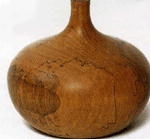|
Turned Wood Emerges as New Art Collectible
Though wood turning is many centuries old, its uses were strictly
utilitarian. However, it was often decorated with carvings. Over the last
decades of the 20th century, interest grew in turned wood objects, so beautiful
that they were displayed and collected as art. Now, such objects are known as
studio art woodenware.
Yet, it wasn't until the late 70s that pieces of
professionally turned wood were accepted by art galleries and later by museums.
These days, many of those pioneer wood turners are known to collectors. Toomey
Auctions in Oak Park, Il., periodically includes them in their art and design
auctions. Prices are hefty. At their September auction, a set of four wood
turned vases by acknowledged master turner Rude Osolnik sold for $1,100. The
tallest was 3.5" high. In a gallery, his pieces can cost over $5,000. An
oil-soaked Norfolk pine bowl with thin walls sold for $550. It was by well-known
turner, Ron Kent (Hawaian-American).
It was the Danish designers who, in the
1950s, first began to exploit the beauty of the various woods used in everyday
objects. Suddenly, the salad bowl and pepper mills came to the table along with
the newly popular stainless steel flatware in modern designs. Dansk, founded by
American Ted Nierenberg, hired top Danish designers. Beautifully grained wood
was finished with rubbed oil instead of varnish. The favored wood was teak with
its varied graining.
In America by the 1950s, wood turners were caught up in
the designs of modernism. It was the perfect addition to the interest in the
merging of organic objects with industrial design. No longer was a wooden bowl
simply round. It could take on various forms, each developed from the natural
forms and even imperfections of the wood. The parts of the trees usually thrown
away, burl and roots, became the artisan's material. Branch growths became
handles.
James Prestini, now considered one of the greatest American masters
of wood turning, began even earlier, in the 1930s, making lathe-turned wood
bowls. He began teaching as a craftsman at the Chicago School of Design
(1939-1946), and interest in wood turning as an art form began to grow, along
with studio art glass and ceramics. In 1950, his work was exhibited at the
Museum of Modern Art in New York. Collectors began to seriously collect. Other
wood turners emerged. Among them Rude Osolnik, Melvin Lindquist, Ed Moulthrop
and David Ellsworth.
CLUES: Each artist is known for specific techniques.
Turning, carving, bleaching and sandblasting among them. Contemporary turners
often include other materials, such as metals, semi-precious stones and even
barbed wire.
David Ellsworth used freestyle turning to enhance defects in
wood, such as rotten areas, splits and bark inclusions. Mel Lindquist discovered
the linear patterning of spalted (splintered) wood, and was the first to use
natural and ruffled edges on turned burl bowls. He also invented tools that
enabled turners to create bottle forms with narrow, tall necks.
Ronald Kent
uses only native Hawaiian Norfolk Island pine. He works with a lathe and hand
tools. Some of his works have knot patterns resembling tortoiseshell. Rude
Osolnik experimented over the years with various woods. His work includes
asymmetrical vessels with cracks and roughly textured edges. All the master
wood turners signed their works.
The Mint Museum in Charlotte, N.C., has the
permanent collection of Jane and Arthur Mason. In addition, an excellent book
about the collection is Turning Wood Into Art, published by Harry N. Abrams and
The Mint Museum.
|

Turned wooden vase by Rude Osolnik; one of a set of four, each in different
wood. Hand-signed, "Osolnik Originals" with name of the wood. Set sold for
$1,100. (Photo: John Toomey Gallery,
Oak Park, IL.)
|